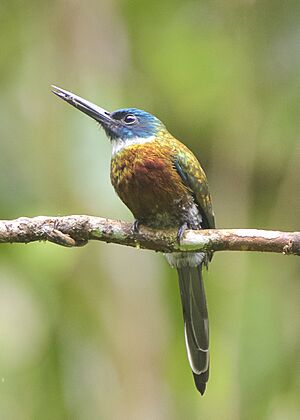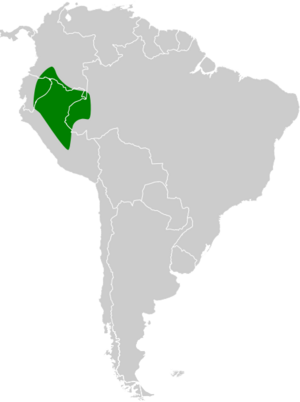Purplish jacamar facts for kids
Quick facts for kids Purplish jacamar |
|
|---|---|
 |
|
| at Tiputini Biodiversity Station, Ecuador | |
| Conservation status | |
| Scientific classification | |
| Genus: |
Galbula
|
| Species: |
chalcothorax
|
 |
|
The purplish jacamar is a beautiful bird found in parts of South America. It lives in countries like Brazil, Colombia, Ecuador, and Peru. This bird is part of a family called Galbulidae, which are known for their bright, shiny feathers. Its scientific name is Galbula chalcothorax.
Contents
What it Looks Like
The purplish jacamar is about 20 to 23 centimeters (8 to 9 inches) long. It weighs around 24.5 to 26.5 grams (about 1 ounce).
The male bird has a dark greenish-black head and face. These parts often have a shiny blue look. Its back and chest feathers can be a metallic reddish-purple or a coppery red. It has a white throat and a belly that looks speckled with black and white.
The female bird is a bit different. Her throat and belly are yellowish-brown or buff-colored instead of white and speckled.
Where it Lives and What its Home is Like
You can find the purplish jacamar in the western Amazon Basin. This area stretches from southeastern Colombia, through eastern Ecuador, and into eastern Peru. It also reaches east into Brazil, as far as the Juruá River.
These birds like to live in the edges and open areas of terra firme forests. This means forests on higher, drier ground, not flooded areas. They live in both old, untouched forests and newer, regrowing forests. You might also see them in woodlands with sandy soil or along rivers. They usually live at elevations up to 500 meters (about 1,640 feet). However, in Ecuador, they have been seen as high as 1,000 meters (about 3,280 feet).
How it Behaves
What it Eats
Scientists don't know exactly what the purplish jacamar eats. But they believe it mostly eats different kinds of flying insects.
These birds often perch alone or in small groups. They usually sit in the lower parts of trees and bushes. When they spot an insect flying by, they quickly dart out to catch it. Sometimes, they even join groups of other bird species that are looking for food together.
Reproduction
There isn't much information available about how the purplish jacamar breeds or raises its young.
Its Calls and Songs
The purplish jacamar's song sounds similar to other jacamar birds. It's a series of rising sounds like "weeee weeee wi-deee wi-deee wi-deee wi-deee." Sometimes, the song ends with a trill, which is a rapid, vibrating sound. You can listen to an example of its song here. Its regular call is a simple "weeee" sound. You can hear its call here.
Conservation Status
The IUCN (International Union for Conservation of Nature) has listed the purplish jacamar as a species of "Least Concern." This means they are not currently in danger of disappearing.
However, not a lot is known about this bird, and it seems to be uncommon in many areas. Experts believe that the loss of its forest home and damage to its habitat might be a threat to the purplish jacamar in the future.


